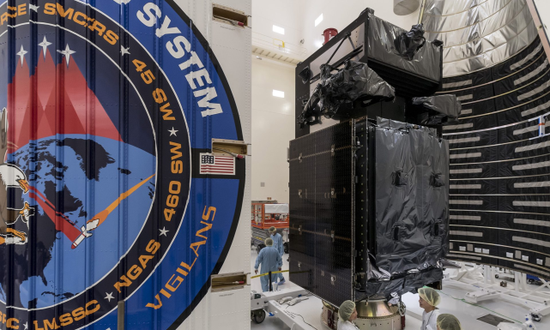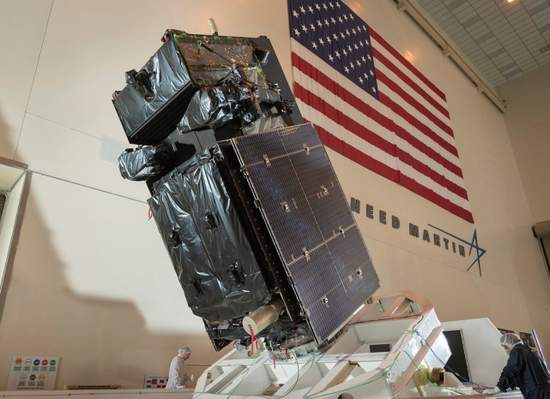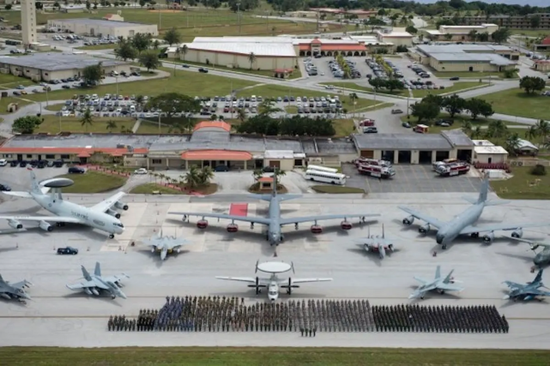https://mil.news.sina.com.cn/china/2020-08-30/doc-iivhuipp1499471.shtml
美能发现我军射几枚导弹也能判断精度 但就是拦不住
美能发现我军射几枚导弹也能判断精度 但就是拦不住
1,142
解放军在南海举行的军事演习,不出意料地引发了西方媒体的热议。然而在演习的部分细节上,西方媒体却出现了报道分歧。《财经时报》等媒体报道称,解放军在演习中发射了一枚东风-26中远程弹道导弹和一枚东风-21D中程弹道导弹。但也有媒体援引不具名的美军官员的话称,解放军实际上发射了4枚导弹。
虽然这些媒体报道出现了分歧。但实际上,美国军方是掌握正确答案的。
美国对于其他国家发展导弹技术,一直是非常忌惮和重视的。但是对于中国和俄罗斯这两个大国而言,哪怕美军在临近地区部署了远程雷达,也无法完全监视其内陆地区的导弹发射活动。因此,从上世纪70年代开始,美国就开始部署红外导弹预警卫星,叫做“国防支援计划卫星”。如今,在轨服役卫星的已经是新一代的产品,名为“天基红外系统”。迄今为止,这套预警系统已经发射了10颗卫星。
导弹预警卫星主要是通过感知弹道导弹起飞时喷出的高温尾焰来发现目标,向己方发出警报,然后持续跟踪、计算导弹的飞行方向,预测落点,供己方指挥官发起拦截行动,或者指挥核反击、组织军民疏散。

[发射前的天基红外卫星,注意左侧整流罩上的图案]
考虑到人类还处在依靠喷气推进实现飞行的技术阶段,再先进的导弹,在其起飞和上升阶段,发动机都要大量喷射高温火焰,这是个明显的红外信号,因此美国导弹预警卫星的作战效能是毋庸置疑的。
早在海湾战争时期,“国防支援计划卫星”就准确发现了伊拉克“飞毛腿”导弹的所有发射,美军在此基础上尝试了人类的第一次反导实战。作为替代型号的“天基红外系统”性能进一步提高。据说它不但能分辨战略导弹、战术导弹发射,还能发现和分辨喷气式飞机的行动。
美国可以用来监视中国内陆导弹发射的卫星数量不少,其中有三颗大椭圆轨道卫星,编号为USA-184、USA-200、USA-259,三颗低轨道卫星,编号为USA-205、USA-208、USA-209。静止轨道卫星的位置是保密的,一般来说大西洋、印度洋各部署一颗,太平洋部署一颗,另一颗机动。负责监控中国内陆任务的是部署在印度洋西部上空的USA-230号卫星,部署在太平洋上空的USA-273号卫星主要用来监视可能进入太平洋发射导弹的核潜艇。所以,解放军到底发射了多少导弹、飞行方向如何,美军心里恐怕清楚得很,只是不肯告诉媒体而已。
前文说到,预警卫星发现导弹起飞之后,被攻击方可以根据反馈的信息实施拦截、反击和疏散。这三种行动的前提是判断导弹落点,如果不是来攻击自己的,就不需要胡乱作出反应,而末段拦截和疏散则需要更精确的落点预判。如果在纽约拉响了警报,弹头却落到了芝加哥,岂不是闹了笑话?

[测试中的天基红外卫星]
不过对于东风-26和东风-21D这类具备末段机动能力的导弹型号来说,落点预判几乎是“不可能的任务”。
传统弹道导弹在发动机关机、进入中段飞行之后,就失去了机动调整弹道轨迹的能力。分导式多弹头可能在飞行中段发生弹道的细微变化,但是再入大气层之后就很难再进行机动了。因此只需要在上升段判断出导弹飞行方向,就可以预测它的末段弹道和落点,无非是一个精度问题。
可是,如果弹头在进入大气层之后还能机动,就会让对方完全抓瞎。要知道,“弹道导弹打航母”只是一个技术目标。只要具备了这种能力,指挥员可以在实战中灵活选择打击对象。特别是面对聚集大量高价值目标的地方,打哪个不打哪个,先打哪个后打哪个,都可以根据实际战术需求来决定。港口里的战舰与核潜艇、岸上的机场和战略轰炸机、油库和雷达……在被击中之前,谁也不知道攻击方的导弹是瞄准什么目标的。从目前来看,末段机动式导弹也是无法被拦截的,这超过了美国现有各种反导系统的作战能力。
如此说来,似乎美军得到卫星预警情报之后,只剩下了疏散一种选择。固定设施无法疏散,战略轰炸机也很难在短时间里起飞疏散,那海上航行中的大型战舰能不能赶紧开足马力逃命呢?事实上,这也是不可能的,航母战斗群的速度再快,也不过是30多节而已,而弹道导弹的飞行时间不会超过半个小时,我们假设航母在这段时间里有如神助,可以横向机动出30千米,对反舰弹道导弹的机动能力来说也是微不足道的,和固定靶的区别不大。

[美军关岛基地]
拦不住、躲不开,最后的选择似乎就是对等反击了,然而这却是美军对中国常规弹道导弹意见最大的方面之一。美军有完善的战略核反击流程,启动核反击的前提,是对方打过来的是一枚核导弹。如果对方发射的是常规导弹,美军却用核弹反击,必然遭到对方核武器的再反击,人类历史可能就此划上句号。然而单凭导弹预警卫星,无法知道对方导弹上装的弹头性质。美军只能眼睁睁看着弹头命中,才能决定自己要做些什么。
从美国国防部8月28日发表的声明看,美军不但知道解放军发射了几枚导弹,也基本判断出了导弹命中精度如何。因为如果导弹打偏,以美军的文化习惯,恐怕早就出言嘲讽。
美军指责解放军破坏南海稳定,其实最大的不稳定因素就是美国自己。只有美国彻底放弃对南海事务的干涉,这里才会真正稳定下来。就像中国外交部发言人赵立坚8月27日所说,美国是南海和平稳定的破坏者和麻烦制造者,国际社会对此有目共睹。美方应该停止在南海兴风作浪、挑拨离间,为维护地区和平稳定发挥建设性作用。
关键字 : 中国
我要反馈
Meineng found that the accuracy of several missiles launched by our army can be judged, but it can't be stopped
Meineng found that the accuracy of several missiles launched by our army can be judged, but it can't be stopped
1,142
The military exercises held by the PLA in the South China Sea have not surprisingly triggered heated discussions in the western media. However, on some details of the exercise, the western media had different reports. The financial times and other media reported that the PLA launched a dongfeng-26 medium and long-range ballistic missile and a dongfeng-21d medium range ballistic missile during the exercise. However, some media quoted unnamed U.S. officials as saying that the PLA actually launched four missiles.
Although these media reports are divided. But in fact, the U.S. military has the right answer.
The United States has always been very concerned and attached great importance to the development of missile technology by other countries. However, for China and Russia, the two big powers, even if the US military deployed long-range radars in the nearby areas, they could not completely monitor the missile launching activities in their inland areas. Therefore, since the 1970s, the United States began to deploy infrared missile early warning satellites, called "defense support program satellites.". Today, the satellite in orbit is a new generation of products called "space-based infrared system". So far, the early warning system has launched 10 satellites.
The missile early warning satellite mainly detects the target by perceiving the high temperature plume emitted by the ballistic missile when it takes off, sends an alarm to its own side, and then continuously tracks and calculates the flight direction of the missile and predicts the impact point for its commander to initiate interception action, or command nuclear counterattack and organize civil and military evacuation.
[for space-based infrared satellite before launch, pay attention to the pattern on the left fairing]
Considering that human beings are still in the technical stage of relying on jet propulsion to realize flight, even advanced missiles, in their take-off and ascent stages, need a large number of high-temperature flames from their engines, which is an obvious infrared signal. Therefore, the combat effectiveness of the US missile early warning satellite is beyond doubt.
As early as the Gulf War, the "defense support program satellite" accurately discovered all the launching of Iraq's Scud missiles. On this basis, the U.S. military tried the first anti missile combat of mankind. The "space-based" model is further improved in performance. It is said that it can not only distinguish the launching of strategic missiles and tactical missiles, but also detect and distinguish the actions of jet aircraft.
The United States has a large number of satellites that can be used to monitor China's inland missile launch, including three large elliptical orbit satellites, numbered usa-184, usa-200 and usa-259, and three low orbit satellites, numbered usa-205, usa-208 and usa-209. The location of geostationary satellites is confidential. Generally speaking, one satellite is deployed in the Atlantic Ocean and the Indian Ocean, one is deployed in the Pacific Ocean, and the other is maneuvering. The usa-230 satellite deployed over the western Indian Ocean is responsible for monitoring China's inland task, while the usa-273 satellite deployed over the Pacific Ocean is mainly used to monitor nuclear submarines that may launch missiles into the Pacific Ocean. Therefore, the U.S. military may be very clear about how many missiles the PLA has launched and what the flight direction is. They just refuse to tell the media.
As mentioned above, after the early warning satellite discovers that the missile takes off, the attacked party can intercept, counterattack and evacuate according to the feedback information. The premise of these three actions is to judge the impact point of the missile. If the missile does not come to attack itself, there is no need to make a random response, while the terminal interception and evacuation need more accurate prediction of the impact point. If the alarm was sounded in New York, and the warhead landed in Chicago, wouldn't it be a joke?
[space based infrared satellite under test]
However, for the dongfeng-26 and dongfeng-21d missiles with terminal maneuverability, the impact prediction is almost "impossible task".
The traditional ballistic missile loses the ability of maneuvering and adjusting trajectory after the engine is shut down and enters the middle flight. However, it is difficult to maneuver after re-entry into the atmosphere. Therefore, only by judging the flight direction of the missile in the ascending phase, the trajectory and the impact point of the missile can be predicted.
However, if the warhead can still maneuver after entering the atmosphere, it will completely blind the other party. We should know that "ballistic missile to aircraft carrier" is only a technical target. As long as the commander has this ability, the commander can choose the target flexibly in actual combat. Especially in the face of a large number of high-value targets, which one to fight first and which to fight later can be decided according to the actual tactical needs. Warships and nuclear submarines in ports, airports and strategic bombers on shore, oil depots and radars No one knows what target the attacker's missiles are aiming at until they are hit. From the present point of view, the terminal mobile missile can not be intercepted, which exceeds the operational capability of various existing U.S. anti missile systems.
In this way, it seems that the U.S. military has only one choice of evacuation after receiving satellite warning information. Fixed facilities cannot be evacuated, and strategic bombers are also difficult to take off and evacuate in a short time. Can large warships sailing on the Sea run with full horsepower to escape? In fact, this is also impossible. No matter how fast the aircraft carrier battle group is, it is only more than 30 knots, and the flight time of ballistic missile will not exceed half an hour. We assume that the aircraft carrier has
美能发现我军射几枚导弹也能判断精度 但就是拦不住
美能发现我军射几枚导弹也能判断精度 但就是拦不住
1,142
解放军在南海举行的军事演习,不出意料地引发了西方媒体的热议。然而在演习的部分细节上,西方媒体却出现了报道分歧。《财经时报》等媒体报道称,解放军在演习中发射了一枚东风-26中远程弹道导弹和一枚东风-21D中程弹道导弹。但也有媒体援引不具名的美军官员的话称,解放军实际上发射了4枚导弹。
虽然这些媒体报道出现了分歧。但实际上,美国军方是掌握正确答案的。
美国对于其他国家发展导弹技术,一直是非常忌惮和重视的。但是对于中国和俄罗斯这两个大国而言,哪怕美军在临近地区部署了远程雷达,也无法完全监视其内陆地区的导弹发射活动。因此,从上世纪70年代开始,美国就开始部署红外导弹预警卫星,叫做“国防支援计划卫星”。如今,在轨服役卫星的已经是新一代的产品,名为“天基红外系统”。迄今为止,这套预警系统已经发射了10颗卫星。
导弹预警卫星主要是通过感知弹道导弹起飞时喷出的高温尾焰来发现目标,向己方发出警报,然后持续跟踪、计算导弹的飞行方向,预测落点,供己方指挥官发起拦截行动,或者指挥核反击、组织军民疏散。

[发射前的天基红外卫星,注意左侧整流罩上的图案]
考虑到人类还处在依靠喷气推进实现飞行的技术阶段,再先进的导弹,在其起飞和上升阶段,发动机都要大量喷射高温火焰,这是个明显的红外信号,因此美国导弹预警卫星的作战效能是毋庸置疑的。
早在海湾战争时期,“国防支援计划卫星”就准确发现了伊拉克“飞毛腿”导弹的所有发射,美军在此基础上尝试了人类的第一次反导实战。作为替代型号的“天基红外系统”性能进一步提高。据说它不但能分辨战略导弹、战术导弹发射,还能发现和分辨喷气式飞机的行动。
美国可以用来监视中国内陆导弹发射的卫星数量不少,其中有三颗大椭圆轨道卫星,编号为USA-184、USA-200、USA-259,三颗低轨道卫星,编号为USA-205、USA-208、USA-209。静止轨道卫星的位置是保密的,一般来说大西洋、印度洋各部署一颗,太平洋部署一颗,另一颗机动。负责监控中国内陆任务的是部署在印度洋西部上空的USA-230号卫星,部署在太平洋上空的USA-273号卫星主要用来监视可能进入太平洋发射导弹的核潜艇。所以,解放军到底发射了多少导弹、飞行方向如何,美军心里恐怕清楚得很,只是不肯告诉媒体而已。
前文说到,预警卫星发现导弹起飞之后,被攻击方可以根据反馈的信息实施拦截、反击和疏散。这三种行动的前提是判断导弹落点,如果不是来攻击自己的,就不需要胡乱作出反应,而末段拦截和疏散则需要更精确的落点预判。如果在纽约拉响了警报,弹头却落到了芝加哥,岂不是闹了笑话?

[测试中的天基红外卫星]
不过对于东风-26和东风-21D这类具备末段机动能力的导弹型号来说,落点预判几乎是“不可能的任务”。
传统弹道导弹在发动机关机、进入中段飞行之后,就失去了机动调整弹道轨迹的能力。分导式多弹头可能在飞行中段发生弹道的细微变化,但是再入大气层之后就很难再进行机动了。因此只需要在上升段判断出导弹飞行方向,就可以预测它的末段弹道和落点,无非是一个精度问题。
可是,如果弹头在进入大气层之后还能机动,就会让对方完全抓瞎。要知道,“弹道导弹打航母”只是一个技术目标。只要具备了这种能力,指挥员可以在实战中灵活选择打击对象。特别是面对聚集大量高价值目标的地方,打哪个不打哪个,先打哪个后打哪个,都可以根据实际战术需求来决定。港口里的战舰与核潜艇、岸上的机场和战略轰炸机、油库和雷达……在被击中之前,谁也不知道攻击方的导弹是瞄准什么目标的。从目前来看,末段机动式导弹也是无法被拦截的,这超过了美国现有各种反导系统的作战能力。
如此说来,似乎美军得到卫星预警情报之后,只剩下了疏散一种选择。固定设施无法疏散,战略轰炸机也很难在短时间里起飞疏散,那海上航行中的大型战舰能不能赶紧开足马力逃命呢?事实上,这也是不可能的,航母战斗群的速度再快,也不过是30多节而已,而弹道导弹的飞行时间不会超过半个小时,我们假设航母在这段时间里有如神助,可以横向机动出30千米,对反舰弹道导弹的机动能力来说也是微不足道的,和固定靶的区别不大。

[美军关岛基地]
拦不住、躲不开,最后的选择似乎就是对等反击了,然而这却是美军对中国常规弹道导弹意见最大的方面之一。美军有完善的战略核反击流程,启动核反击的前提,是对方打过来的是一枚核导弹。如果对方发射的是常规导弹,美军却用核弹反击,必然遭到对方核武器的再反击,人类历史可能就此划上句号。然而单凭导弹预警卫星,无法知道对方导弹上装的弹头性质。美军只能眼睁睁看着弹头命中,才能决定自己要做些什么。
从美国国防部8月28日发表的声明看,美军不但知道解放军发射了几枚导弹,也基本判断出了导弹命中精度如何。因为如果导弹打偏,以美军的文化习惯,恐怕早就出言嘲讽。
美军指责解放军破坏南海稳定,其实最大的不稳定因素就是美国自己。只有美国彻底放弃对南海事务的干涉,这里才会真正稳定下来。就像中国外交部发言人赵立坚8月27日所说,美国是南海和平稳定的破坏者和麻烦制造者,国际社会对此有目共睹。美方应该停止在南海兴风作浪、挑拨离间,为维护地区和平稳定发挥建设性作用。
关键字 : 中国
我要反馈
Meineng found that the accuracy of several missiles launched by our army can be judged, but it can't be stopped
Meineng found that the accuracy of several missiles launched by our army can be judged, but it can't be stopped
1,142
The military exercises held by the PLA in the South China Sea have not surprisingly triggered heated discussions in the western media. However, on some details of the exercise, the western media had different reports. The financial times and other media reported that the PLA launched a dongfeng-26 medium and long-range ballistic missile and a dongfeng-21d medium range ballistic missile during the exercise. However, some media quoted unnamed U.S. officials as saying that the PLA actually launched four missiles.
Although these media reports are divided. But in fact, the U.S. military has the right answer.
The United States has always been very concerned and attached great importance to the development of missile technology by other countries. However, for China and Russia, the two big powers, even if the US military deployed long-range radars in the nearby areas, they could not completely monitor the missile launching activities in their inland areas. Therefore, since the 1970s, the United States began to deploy infrared missile early warning satellites, called "defense support program satellites.". Today, the satellite in orbit is a new generation of products called "space-based infrared system". So far, the early warning system has launched 10 satellites.
The missile early warning satellite mainly detects the target by perceiving the high temperature plume emitted by the ballistic missile when it takes off, sends an alarm to its own side, and then continuously tracks and calculates the flight direction of the missile and predicts the impact point for its commander to initiate interception action, or command nuclear counterattack and organize civil and military evacuation.
[for space-based infrared satellite before launch, pay attention to the pattern on the left fairing]
Considering that human beings are still in the technical stage of relying on jet propulsion to realize flight, even advanced missiles, in their take-off and ascent stages, need a large number of high-temperature flames from their engines, which is an obvious infrared signal. Therefore, the combat effectiveness of the US missile early warning satellite is beyond doubt.
As early as the Gulf War, the "defense support program satellite" accurately discovered all the launching of Iraq's Scud missiles. On this basis, the U.S. military tried the first anti missile combat of mankind. The "space-based" model is further improved in performance. It is said that it can not only distinguish the launching of strategic missiles and tactical missiles, but also detect and distinguish the actions of jet aircraft.
The United States has a large number of satellites that can be used to monitor China's inland missile launch, including three large elliptical orbit satellites, numbered usa-184, usa-200 and usa-259, and three low orbit satellites, numbered usa-205, usa-208 and usa-209. The location of geostationary satellites is confidential. Generally speaking, one satellite is deployed in the Atlantic Ocean and the Indian Ocean, one is deployed in the Pacific Ocean, and the other is maneuvering. The usa-230 satellite deployed over the western Indian Ocean is responsible for monitoring China's inland task, while the usa-273 satellite deployed over the Pacific Ocean is mainly used to monitor nuclear submarines that may launch missiles into the Pacific Ocean. Therefore, the U.S. military may be very clear about how many missiles the PLA has launched and what the flight direction is. They just refuse to tell the media.
As mentioned above, after the early warning satellite discovers that the missile takes off, the attacked party can intercept, counterattack and evacuate according to the feedback information. The premise of these three actions is to judge the impact point of the missile. If the missile does not come to attack itself, there is no need to make a random response, while the terminal interception and evacuation need more accurate prediction of the impact point. If the alarm was sounded in New York, and the warhead landed in Chicago, wouldn't it be a joke?
[space based infrared satellite under test]
However, for the dongfeng-26 and dongfeng-21d missiles with terminal maneuverability, the impact prediction is almost "impossible task".
The traditional ballistic missile loses the ability of maneuvering and adjusting trajectory after the engine is shut down and enters the middle flight. However, it is difficult to maneuver after re-entry into the atmosphere. Therefore, only by judging the flight direction of the missile in the ascending phase, the trajectory and the impact point of the missile can be predicted.
However, if the warhead can still maneuver after entering the atmosphere, it will completely blind the other party. We should know that "ballistic missile to aircraft carrier" is only a technical target. As long as the commander has this ability, the commander can choose the target flexibly in actual combat. Especially in the face of a large number of high-value targets, which one to fight first and which to fight later can be decided according to the actual tactical needs. Warships and nuclear submarines in ports, airports and strategic bombers on shore, oil depots and radars No one knows what target the attacker's missiles are aiming at until they are hit. From the present point of view, the terminal mobile missile can not be intercepted, which exceeds the operational capability of various existing U.S. anti missile systems.
In this way, it seems that the U.S. military has only one choice of evacuation after receiving satellite warning information. Fixed facilities cannot be evacuated, and strategic bombers are also difficult to take off and evacuate in a short time. Can large warships sailing on the Sea run with full horsepower to escape? In fact, this is also impossible. No matter how fast the aircraft carrier battle group is, it is only more than 30 knots, and the flight time of ballistic missile will not exceed half an hour. We assume that the aircraft carrier has
